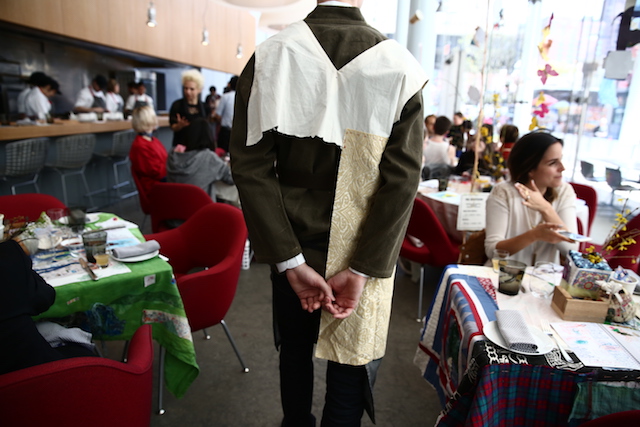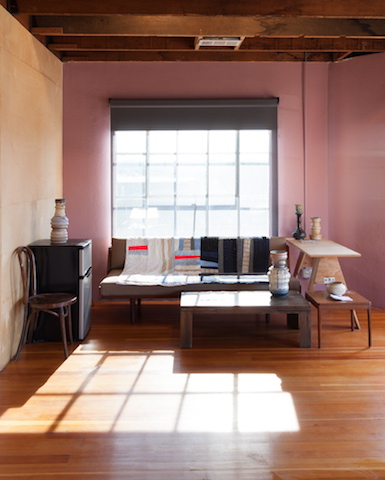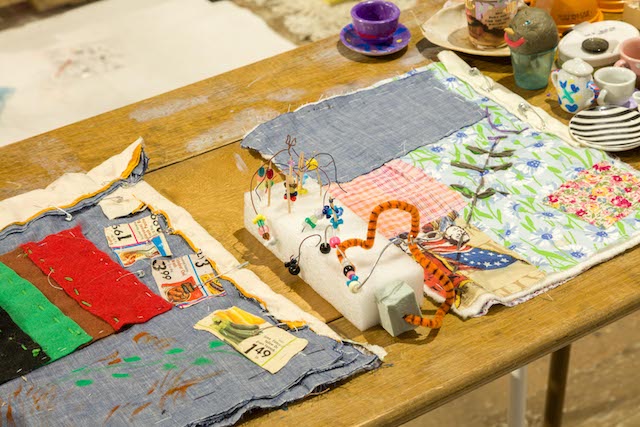Growing up, Susan Cianciolo was a runner. Now, as an artist, running has become her philosophy. Here is a natural animal activity that pretty much anyone can do, and yet within that fundamental movement is struggle, risk, visceral exhaustion, ecstatic peaks and the freewheeling sprint of liberation.
From 1995 to 2001, Cianciolo produced 11 collections of her defiant, innovative RUN clothing line, as well as a pop-up restaurant under the same name. (She’s also made RUN structures, RUN money, a RUN Library, RUN Church and on.) The clothes were raw, handmade and tender, and had just the right amount of naivety – all uncommon qualities in high fashion. Every strip of fabric expressed its own idiosyncratic personality, its own movement across the body and its own complicated history. She sometimes commissioned materials from seed to cloth, but more often, her fabrics are recycled, gifted, found.
Likewise, her runway shows played like performance art, staged in parking garages and galleries, and her models, primarily women, were often nonprofessionals or children or, on one occasion, aerialists. Since then, she has referred to the RUN project and its community, lovingly, as a ‘cult’, and she too has achieved a certain cult status from its legacy.
In 2001 Cianciolo experienced psychological burnout and left the fashion industry along with her life in New York. She began focusing on her visual art, which had been quietly running in parallel to her fashion career all along. The art overlapped with her fashion, both in sensibility and content, and her shows seemed casually to ignore any distinction between the disciplines: dreamlike films of women in her clothes, fashion sketches, magazine collages, geometric watercolours and exhibitions of the clothes themselves, which she often referred to as costumes.
Cianciolo also began showing her signature DIY kits (originally called Fluxus boxes). These ragged cardboard boxes were like care packages filled with fragments from her life and work – a doll, a Polaroid, a moment from a scrapbook, a childlike sculpture of popsicle sticks, a page from her actual diary. Cianciolo has said her work is often inspired by her memories, and these modest vessels play with nostalgia, their contents recalling precious keepsakes discovered in a grandmother’s attic. In fact, like much of Cianciolo’s work, the items in the kits are intended to be used, and the clothing can be assembled at home.
Home is another significant word in Cianciolo’s body of work. Raised in the inner city of Providence, Rhode Island, in relative poverty, Cianciolo learned craft early, making her own clothing whenever possible. These days she works mostly from home and often involves her ten-year-old daughter, Lilac Sky, in performances and in the making of objects. With designer Kiva Motnyk, she also created RUN Home, a line of housewares that includes quilts, cushions, tapestries, table linens, ceramics and furniture. Like the artists Mierle Laderman Ukeles and Alison Knowles, Cianciolo elevates domestic labour and humbles the luxurious pretence of fine art.
In 2015, at the age of forty-six, Cianciolo presented her first exhibition in New York in over 12 years: if God COMes to visit You, HOW will you know? (the great tetrahedral kite) at Bridget Donahue on Manhattan’s Lower East Side. With bare walls and an austere grid of kits on the floor, Cianciolo created something simultaneously delicate and unrefined, sacred and mundane, inviting and mystifying. The show received a waterfall of long-deserved attention and stimulated a new period in Cianciolo’s career, which has included her second iteration of Run Restaurant, at the 2017 Whitney Biennial, and a screening of her films in MoMA PS1’s 2015 Greater New York survey.
I spoke to Cianciolo as she was preparing a new performance and a solo show in Los Angeles. She spoke softly, and found her words through long thoughtful pauses. Her answers were profoundly, refreshingly honest, and afterwards I felt much like I did after seeing her work: I had just experienced the very centre of a human. Later, in an email, she revealed to me that she has never discussed “this part of [her] story” publicly.
ROSS SIMONINI Would you say that you walked away from the fashion industry in 2001?
SUSAN CIANCIOLO Yeah. When I speak to doctors and healers about it, they say I had a mental breakdown. But it probably was just an overload, too much overstimulation for too long without any breaks.
RS Did it feel like a mental breakdown to you?
SC Definitely. Something went – the wiring was not right when I hit that point.
RS What did you do to get yourself back to some kind of balance?
SC Well, being such an extremist – and I don’t know if this was right – I just cut all my ties completely. Shut down the studio. Let everyone go. Separated from my husband. I moved out to the Albers foundation for three months and lived completely alone on 75 acres, right outside of Yale. Then I went to London and didn’t come back for a year.
RS What were you doing during that period?
SC Making films and a lot of work. But by myself. I didn’t have the big studio any more. I was travelling and making shows. I stopped working with my agent, but I was still making clothes and presenting them through exhibitions. I was making the kits at that time, which included clothing, but I was calling them games.
RS Was there a moment when you felt that you had moved past the breakdown?
SC Well, I moved back to New York in 2003 and I was a little bit homeless for a while until I settled in Brooklyn. But then an unexpected thing happened. I died and came back to life. I flatlined. And that changed my life forever until today. Nothing has been the same.
RS How did that happen?
SC I was walking through Prospect Park and I was scheduled, the next day, to have an exhibition of my collages at Sears-Peyton Gallery. I had everything laid out in my little studio in Brooklyn, and I went for a walk in the morning, just to step out of the studio. And that was it: I was knocked down by this guy on a bike. And he beat me to death with a bicycle chain, and strangled me, and raped me. And from that day until now, I’ve had to work towards recovering. Mentally, physically – I’ve never been the same. It took years and years and years to walk down the street, to function. And my brain never really recovered. So when I say my ‘doctors and healers’ – that’s why I have so many. I’ve worked with the best acupuncturists in the world.
RS Has anything helped?
SC Meditation. I don’t know if people notice, but all my work is connected to spiritual theories.
RS What’s it like to be alive after dying?
SC It’s as if I am on a strange middle plane of always knowing I already died, so there is nothing to be afraid of – and also being so afraid to know it can happen again, at any moment.

RS How could you stay in New York after that experience?
SC The only reason I’m still here is because I didn’t want to let it beat me. It took me ten years to have the courage to move back to Brooklyn. Now, my daughter and I have been here for six years. But still, it’s just constant flashbacks all the time. Just little things. Like, when I had my solo show with Bridget [Donahue] in Manhattan two years ago, that was the first time I had a solo show in New York in 12 years. Because my brain believed that I would just die if I did it.
RS Right, the association.
SC And when I did that, I was like, I’ve made it! I’ve learned so much about the tricks of the mind. I’ve always been prayer-based, even before all this, but now it’s the main part of my life. I’ve come to learn that I don’t even know myself.
RS Has this experience radically affected your work?
SC I think that’s why there’s so much isolation now. To get to the work, I need an extraordinary amount of time alone.
RS That’s surprising, because the work seems so communal – the performances, the collections.
SC Yeah, it’s true. And I even just brought an intern on. And I have another project called RUN Home, and that’s my outlet for community. Anytime someone contacts me, that’s how I work with them, through RUN Home. But it’s true, my shows are performance-based and community-based. That’s why I have to make sure I have enough time alone. To get into a meditation. My certain zone.
RS Lilac is also collaborating on some of the work now.
SC And it’s a constant question: did I make the right choice to have a child? Should I bring her into this life? Because I’m obsessed with my work, and that’s the world she’s been placed into. And yeah, she ends up helping with a lot of work. There are a lot of times when we are stuck in the house for endless days and nights, so whatever I make, she makes. I told her yesterday that I titled an edition she worked on as being created by both of us. And I told her she has to sign 100 editions. But she wouldn’t do it.
RS How has motherhood affected you as an artist?
SC I don’t meet many other artist parents. I feel very alone on this island. And it’s busy. I have to make muffins today. And I decided to throw [Lilac] this surrealist birthday. It’s so much work. I’m always asking myself whether I should have brought her into this world. It’s different, how we do things, and I hope that’s okay. I did a Run Restaurant piece for the Whitney Biennial with her, and she’s coming to LA with me for my upcoming show at Overduin & Co. I try to separate, but it all gets mushed together. I wonder if she’d be better doing normal kid things. Even the birthday party, I tried to do something normal, but we both ended up wanting to do this wild, surrealist thing at my friend’s studio.
RS I’ve read you talking about your poverty as an artist. Not eating for weeks at a time.
SC We were poor. Oh, we were. And that must have really affected her. She’s been my whole inspiration to have a good income. It was horrible. She was three, I think, when I finally took the job at Pratt [Institute]. Now I’m on a full-time tenure track.
RS What do you teach?
SC I was hired to teach the senior thesis collection, but I also teach an untraditional class I developed at Parsons [School of Design] about fashion drawing.
RS The format of the DIY kit seems to connect with your teaching. Have the kits always been a part of your work?
SC Always. And that’s funny, because I’ve changed, but in some ways the work hasn’t.
RS Do you remember how the kits started?
SC Those early RUN collections got more and more complicated, and the pieces started coming apart. I wanted the audience and customer to use their own creativity and intelligence to put it back together. That was fascinating to me. The early ones were the do-it-yourself skirt kits, and I made a film about them. Then the collections all became kits: 9, 10, 11. Then, in London, I started showing them as exhibitions.
RS: I’ve heard you say that these collections come from visions, or insights.
SC I try to track myself back to my twenties, in my Canal Street studio, Chinatown. Back then, with all those people around me, those collections were based on visions, but it was different. Now the format is so much clearer. With meditation, it’s not as if I press a button and it appears, but there are moments where something appears, you know? I don’t know what it is, or how it works, but my teachers tell me that I work with spirits. So that’s what I follow and, every day, what I pray for – that I can be that vehicle. I mean, it sounds so arrogant to me to put it into physical words. Who am I to even know? But that’s why I need more isolation when I’m making the work.

RS Would you say you’re more able to experience those insights now?
SC Well, there’s a show up now at Bard [Fashion Work, Fashion Workers, at the Hessel Museum] of my early work, and when I look at it, it still feels meaningful and intuitive and raw, so I can’t say what I do now is better. I still wake up every day and don’t know if the next day will come that I’ll hear the answer. I go into these shows not knowing if it will even work out. I really believe that if I don’t hear the voice to tell me how to do it, I can’t make the work. I can’t install that show. Like, right now, I had to put a performance on hold because I haven’t heard the voice. People keep asking and I don’t know. I can’t go forward.
RS Is that frightening?
SC Yeah. It’s always been scary. Every time. I’ve learned to have a blind faith in the work. It’s the only thing I live for. And that’s the concern of bringing a child into it.
RS Do you still go to an ashram?
SC That was a place you could bring a child from the day they were born. With most yoga studios, you can’t bring a crying baby. You can’t even bring a ten-year-old. Yoga studios will tell you, don’t ever come back with that child! [laughs] But at the ashram, they let her in. And I started doing kundalini yoga all the time, and it pushed my psyche, and it informed a lot of my work. But now I don’t go to any classes. That’s not what my meditation is these days.
RS Do you see your work as sacred?
SC Yes. Yes.
RS Are you informed by looking at other historical, sacred work? Do you see your work in that tradition?
SC It’s a good question. I’ve been asking my teachers about this, because recently I’ve been seeing physical manifestations. It will be at the most random time and place. And so I draw those things. I think the work is just made for god.
RS Everything?
SC Yeah. One of my oldest and closest friends was born and grew up in Jamaica. I’ve visited her many times, and every time I go, I learn about more of the artists from there. For many of them, that was the sole purpose of their work. That was their only living purpose.
RSMaking art as a form of worship, ritual.
SC That’s how I think of the performances. I went to see the show of my older work at Bard and I heard a voice that said, you have to do a performance. But I didn’t know how, or what. I had to start studying my old performances to understand. But I know it will be a ritual, a celebration.
RSDo you think a viewer has to experience the film, the clothing, the collage – all of it – to know the full experience? Or is your whole project contained within each object?
SC It’s all contained within each piece. But really, one show is one piece for me. That’s how the fashion shows were. And the exhibitions are just a background for the performance. It’s all based on visions. It’s all one thing. But in those two-and-half years since I’ve submerged myself into the artworld, I’ve really had to learn how shows have to break down. How it sells. It’s a business now. I mean, I was so freefloating for so long. I don’t even do titles or anything. When you start breaking down each thing from a show, it’s so tedious. Bridget [Donahue] usually just makes up the titles, the numbers. That stuff doesn’t interest me.

RSHow has the artworld treated you?
SC I just try to not overthink it. I don’t want to know what’s going on. I can’t get to shows. It makes me feel too uncomfortable to leave my child. It may seem, from the outside, like we’re in the artworld, but we are so out of it. Every night, when there’s something going on, we’re just making the same cookies, over and over again. That’s the truth.
RS It seems like you used to be a pretty public personality, though, in your twenties.
SC When I was married to Aaron Rose [gallerist, filmmaker], that was somewhat true. But really, I was always the person who said no and worked.
RS In the future, do you think you’ll be continuing the same path as an artist?
SC No. The show I’m working on now [for Overduin & Co] feels new and different. It’s wooden geometrical sculptures that came to me in a vision. There’s furniture. There’s a sound component of my [meditation] teacher, because I finally got the courage to ask him if I could use his recordings. It feels like a breakthrough. But is that a cliché? That term? Maybe on the outside it looks the same, but I don’t care what it looks like to anyone else. To me, it feels new.
Ross Simonini is an artist and writer living in New York and California
From the Summer 2018 issue of ArtReview
